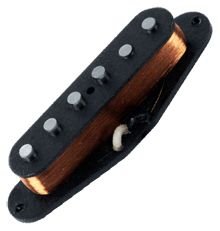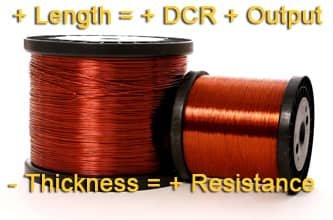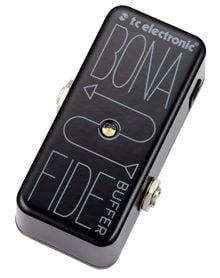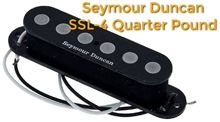
The output or gain of electric guitar pickups is determined by its output voltage, measured in millivolts and detailed with the abbreviation mV.
The output that a pickup can offer us depends mainly on the magnet power, and on the length or number of turns of copper wire of which its coil is made up, or its coils in the case of double pickups.

The higher the output voltage, the greater the pickup gain and the easier it will be to saturate or distort an amplifier. Consequently, with the same amplifier settings, the distortion will increase as the output voltage of the pickup increases.
So this information is one of the most interesting to know before buying an electric guitar pickup, in order to guide it towards the sound we want to achieve.
Although if we talk about versatility, we should opt for low or medium gain pickups. With this type of pickup we can progressively saturate the sound, by raising the gain of the amplifier or our distortion pedals. In contrast, high-gain pickups are more geared towards distortion.
Electric Guitar Pickups: Standard Output
Output power can be listed as RMS output, or Peak watts. These two forms of measurement can lead to confusion, since the RMS output would be the average power of the pickup, not the maximum peak output. The RMS output would be the most appropriate to detail, and it is the one I will use to refer to general terms.

On a single-coil pickup, its output voltage can typically range from 100 to 200 mV. In double-coil pickups or humbuckers, they are usually found around 200 mV for the vintage-style models, 300 mV for medium-gain models, and up to 500 mV for the most extreme models.

This would be on passive pickup models. In active pickups things change a lot, as this type of circuit incorporates a preamplifier powered by a 9 volt battery. For this reason, active pickups can exceed 1 volt output, as in the case of the popular EMG 81 and 85.
Exact output information for a pickup is an interesting fact to know, but this review is not usually detailed in manufacturers’ specifications. Although some brands like DiMarzio, usually clearly detail the output of their pickups in millivolts.
However, many other brands do not usually provide this information, and only opt to report the resistance or impedance of their products.
What is Resistance or Impedance?

The resistance is usually detailed as impedance or DCR (direct current resistance) and its unit of measurement is the kilohm, detailed simply with the letter K.
This resistance is determined by the thickness of the copper wire, and by the length or number of turns of which the coil of the electromagnetic pickup is made up. In short, the longer the cable length, the higher its output and resistance. And the smaller the section of the copper wire, the greater the resistance or impedance. Although this last issue does not influence the pickup output.
Resistance is usually higher in higher-gain pickups, as the number of turns influences the pickup’s output, but this would not be definitive information for determining its voltage. Although some brands incorrectly detail this data as output.
To demonstrate how incorrect this information can be, I will give you two examples. The first is the DiMarzio DP186 The Cruiser with a 5.75K resistor, but instead has an average output of 140 millivolts.

The case of the DiMarzio DP117 HS3 is even more extreme with a very high resistance of 23.72 K, and a minimum output of only 93 mV.
DiMarzio may have detailed the exact mV output of his pickups because of this extreme play in their impedances. And other brands do without this information due to its greater coherence between resistance and output. But this will only know the manufacturers themselves.
Guitar Pickups OUTPUT: Magnets
Since we have talked about the copper wire and how it can influence the output of the pickup, we will also talk about the magnet. The other factor that directly influences the output of the pickup.
As I mentioned earlier, the more powerful the magnet, the greater its magnetic flux. Therefore, a coil with the same number of copper wire turns will have a higher output as its magnet becomes more powerful.
The most powerful magnets in general would be ceramic or ferrite magnets. So, if a pickup has this type of magnet, it is most likely a high-gain pickup, or at most a medium-gain one.
Although I wouldn’t be surprised if there was a low output model that mounts a ferrite magnet. Since this also depends on the size and power of this magnet, and as has been commented on the length of the coil cable.
Disadvantages of Very Strong Magnets
In any case, the use of very powerful magnets can be detrimental to the quality of our sound, due to the generation of a stronger magnetic field that can influence the free vibration of the strings, thereby reducing their wave amplitude, and therefore its sustain.
On the contrary, other models of electromagnetic pickups opt for increasing the number of turns in the coil to achieve a higher output, which would increase the impedance. This factor can affect the higher frequencies or treble.
This problem can be mitigated by installing a buffer in our effects chain, so those frequencies don’t get further deteriorated.

Alnico V or alnico II magnets are often used on vintage models, or low output pickups. Although also by increasing the size or power of this type of magnet we can achieve a high output, as in the case of the Seymour Duncan SSL-4 Quarter Pound.

In any case, in general, the output of electric guitar pickups is usually detailed with a brief low or vintage output, medium output, and high output or high gain. This may be enough to guide us towards the correct purchase.
